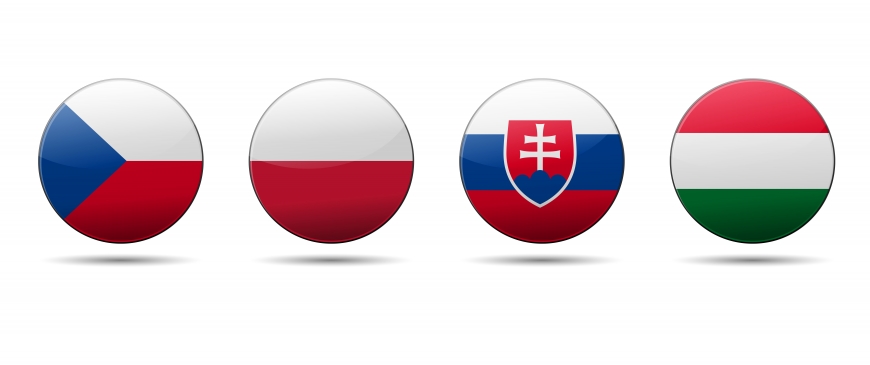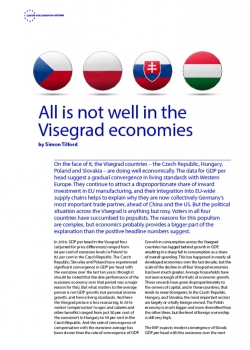
All is not well in the Visegrad economies
On the face of it, the Visegrad countries – the Czech Republic, Hungary, Poland and Slovakia – are doing well economically. The data for GDP per head suggest a gradual convergence in living standards with Western Europe. They continue to attract a disproportionate share of inward investment in EU manufacturing, and their integration into EU-wide supply chains helps to explain why they are now collectively Germany’s most important trade partner, ahead of China and the US. But the political situation across the Visegrad is anything but rosy. Voters in all four countries have succumbed to populists. The reasons for this populism are complex, but economics probably provides a bigger part of the explanation than the positive headline numbers suggest.
In 2016, GDP per head in the Visegrad four (adjusted for price differences) ranged from 64 per cent of eurozone levels in Poland to 82 per cent in the Czech Republic. The Czech Republic, Slovakia and Poland have experienced significant convergence in GDP per head with the eurozone over the last ten years (though it should be noted that the dire performance of the eurozone economy over that period was a major reason for this). But what matters to the average person is not GDP growth, but personal income growth, and hence living standards. And here the Visegrad picture is less reassuring. In 2016 worker ‘compensation’ (wages and salaries and other benefits) ranged from just 50 per cent of the eurozone’s in Hungary to 59 per cent in the Czech Republic. And the rate of convergence of compensation with the eurozone average has been slower than the rate of convergence of GDP.
Growth in consumption across the Visegrad countries has lagged behind growth in GDP, resulting in a sharp fall in consumption as a share of overall spending. This has happened in nearly all developed economies over the last decade, but the scale of the decline in all four Visegrad economies has been much greater. Average households have not seen enough of the fruits of economic growth. Those rewards have gone disproportionately to the owners of capital, and in these countries, that tends to mean foreigners. In the Czech Republic, Hungary, and Slovakia, the most important sectors are largely or wholly foreign-owned. The Polish economy is much bigger and more diversified than the other three, but the level of foreign ownership is still very high.
Growth in consumption across the #Visegrad countries has lagged behind growth in GDP, resulting in a sharp fall in consumption as a share of overall spending.
The IMF expects modest convergence of Slovak GDP per head with the eurozone over the next five years, but minimal convergence in Czech and Polish levels and none at all in Hungary’s. This is partly because the IMF expects eurozone growth of 1.7 per cent per year over the next five years compared with just 0.8 per cent per year in the proceeding five, but it also reflects disappointing Visegrad economic growth, Slovakia aside. Of course, worker incomes might increase more rapidly than GDP per head over the next five years, reversing the pattern of the previous ten. The Visegrad countries should continue to attract manufacturing investment. After all, with the right investment, productivity levels equal those in the West, but with dramatically lower labour costs. Labour forces are stagnant or shrinking, which could start to push up wages in the manufacturing sector. And as these operations are so profitable and so conveniently placed geographically for their predominately German owners, moderate wage increases are unlikely to prompt firms to relocate operations to cheaper locations in Bulgaria or Romania.
But the big question is whether these foreign firms will shift more of the value-added in their production into these economies, boosting demand for professionals as opposed to production line workers. For example, will foreign car firms start doing more of the engineering (as opposed to just assembly) of their cars in the Visegrad? This will partly depend on the success of the Visegrad economies in raising education levels. While their apprenticeship and vocational training systems are strong, levels of advanced technical training, as well as higher education more generally, are less impressive, not least because many highly-skilled workers have opted to migrate to wealthier member-states. In common with all EU countries, Visegrad governments have cut investment in education and training in recent years as part of a drive to hold down public deficits.
#Visegrad countries need to evolve their growth strategies away from the current preponderant dependence on foreign direct investment.
More fundamentally, the Visegrad countries need to evolve their growth strategies away from the current preponderant dependence on foreign direct investment. Such investment is important, but will not lead to sustained convergence in living standards, especially in an economy the size of Poland’s. Instead of competing to offer the most favourable tax environment to foreign investors, they need to focus on ensuring that local firms have what they need to flourish – skilled labour, infrastructure, finance, and transparent and predictable business environments. There is nothing unique about the challenge the Visegrad four face – they share it with other peripheral regions of the EU, from much of southern Europe to the poorer parts of the UK and Ireland. In addition to stepping up investment in skills, they need to prioritise infrastructure in an effort to spread wealth from the capital cities into the surrounding (much poorer) provinces. Such spending will push-up fiscal deficits in the short-term, but because of its strong multiplier effects, investment would not undermine long-term debt sustainability.
But there is one area where the Visegrad countries face a particular challenge: demographics. They are not alone in Europe in facing fast ageing populations. For example, Spain, Italy and Germany have similarly low birth rates. But these Western countries have positive net immigration; the Visegrad do not. Over the last 20 years, the Czech and Slovak populations have held their ground, but Polish and Hungarian ones have fallen, the latter sharply. Freedom of movement has no doubt been a boon to the workers from these countries who have chosen to move elsewhere, but it is less clear whether it has been a boon for the Visegrad countries themselves because it has denuded them of many of their young and best-educated workers and entrepreneurs, and made their societies less open. Of course, some may choose to return home at some point, but this is only likely if suitable jobs are available at comparable incomes to those they currently have.
The disappointing degree of income convergence between the Visegrad and the eurozone does not explain the racism and xenophobia on display across these economies, or their voters’ readiness to support parties determined to erode the independence of domestic political institutions. But it does make it easier to understand why the popular mood in these countries is unsettled and why voters are prepared to give non-mainstream parties a chance. The Visegrad cannot roll back foreign investment, and would be crazy to try; protectionism is no solution. But it is not hard to understand why workers feel that they are second-class EU citizens when they are paid a fraction of their Western counterparts for doing similar work, or to appreciate how the high degree of foreign ownership could leave people feeling that they have lost any meaningful national control.
Unfortunately, the populists in power in the region, like populists everywhere, are good at exploiting resentment and fear, but poor at providing the answers to policy challenges. The most likely outcome is that they will do nothing to strengthen domestic economies while alienating foreign investors through nationalist rhetoric and attacks on the rule of law.
Simon Tilford is deputy director of the Centre for European Reform.

